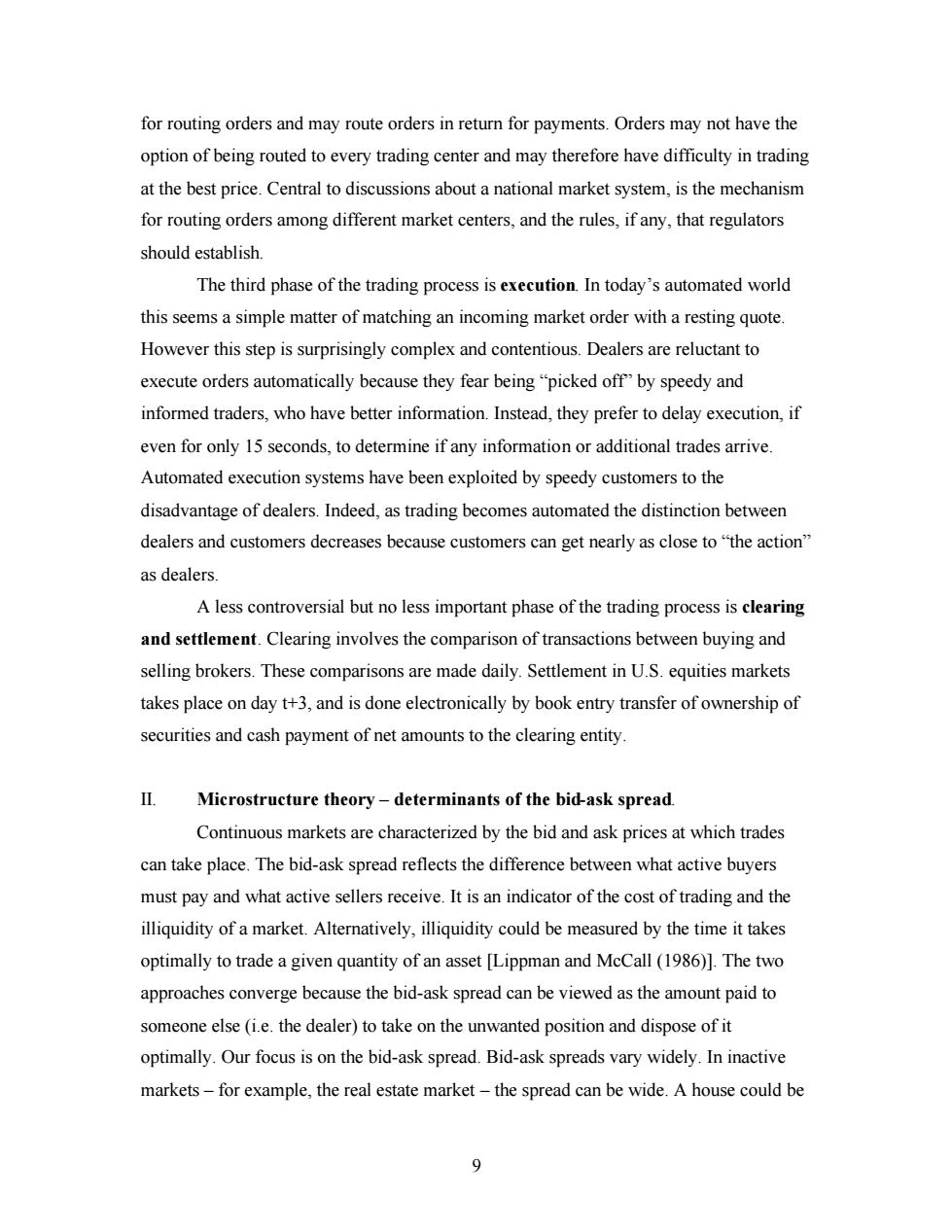
for routing orders and may route orders in return for payments.Orders may not have the option of being routed to every trading center and may therefore have difficulty in trading at the best price.Central to discussions about a national market system,is the mechanism for routing orders among different market centers,and the rules,if any,that regulators should establish The third phase of the trading process is execution.In today's automated world this seems a simple matter of matching an incoming market order with a resting quote. However this step is surprisingly complex and contentious.Dealers are reluctant to execute orders automatically because they fear being"picked off by speedy and informed traders,who have better information.Instead,they prefer to delay execution,if even for only 15 seconds,to determine if any information or additional trades arrive. Automated execution systems have been exploited by speedy customers to the disadvantage of dealers.Indeed,as trading becomes automated the distinction between dealers and customers decreases because customers can get nearly as close to"the action" as dealers A less controversial but no less important phase of the trading process is clearing and settlement.Clearing involves the comparison of transactions between buying and selling brokers.These comparisons are made daily.Settlement in U.S.equities markets takes place on day t+3,and is done electronically by book entry transfer of ownership of securities and cash payment of net amounts to the clearing entity. Ⅱ. Microstructure theory-determinants of the bid-ask spread Continuous markets are characterized by the bid and ask prices at which trades can take place.The bid-ask spread reflects the difference between what active buyers must pay and what active sellers receive.It is an indicator of the cost of trading and the illiquidity of a market.Alternatively,illiquidity could be measured by the time it takes optimally to trade a given quantity of an asset [Lippman and McCall(1986)].The two approaches converge because the bid-ask spread can be viewed as the amount paid to someone else (i.e.the dealer)to take on the unwanted position and dispose of it optimally.Our focus is on the bid-ask spread.Bid-ask spreads vary widely.In inactive markets-for example,the real estate market-the spread can be wide.A house could be 9
9 for routing orders and may route orders in return for payments. Orders may not have the option of being routed to every trading center and may therefore have difficulty in trading at the best price. Central to discussions about a national market system, is the mechanism for routing orders among different market centers, and the rules, if any, that regulators should establish. The third phase of the trading process is execution. In today’s automated world this seems a simple matter of matching an incoming market order with a resting quote. However this step is surprisingly complex and contentious. Dealers are reluctant to execute orders automatically because they fear being “picked off” by speedy and informed traders, who have better information. Instead, they prefer to delay execution, if even for only 15 seconds, to determine if any information or additional trades arrive. Automated execution systems have been exploited by speedy customers to the disadvantage of dealers. Indeed, as trading becomes automated the distinction between dealers and customers decreases because customers can get nearly as close to “the action” as dealers. A less controversial but no less important phase of the trading process is clearing and settlement. Clearing involves the comparison of transactions between buying and selling brokers. These comparisons are made daily. Settlement in U.S. equities markets takes place on day t+3, and is done electronically by book entry transfer of ownership of securities and cash payment of net amounts to the clearing entity. II. Microstructure theory – determinants of the bid-ask spread. Continuous markets are characterized by the bid and ask prices at which trades can take place. The bid-ask spread reflects the difference between what active buyers must pay and what active sellers receive. It is an indicator of the cost of trading and the illiquidity of a market. Alternatively, illiquidity could be measured by the time it takes optimally to trade a given quantity of an asset [Lippman and McCall (1986)]. The two approaches converge because the bid-ask spread can be viewed as the amount paid to someone else (i.e. the dealer) to take on the unwanted position and dispose of it optimally. Our focus is on the bid-ask spread. Bid-ask spreads vary widely. In inactive markets – for example, the real estate market – the spread can be wide. A house could be
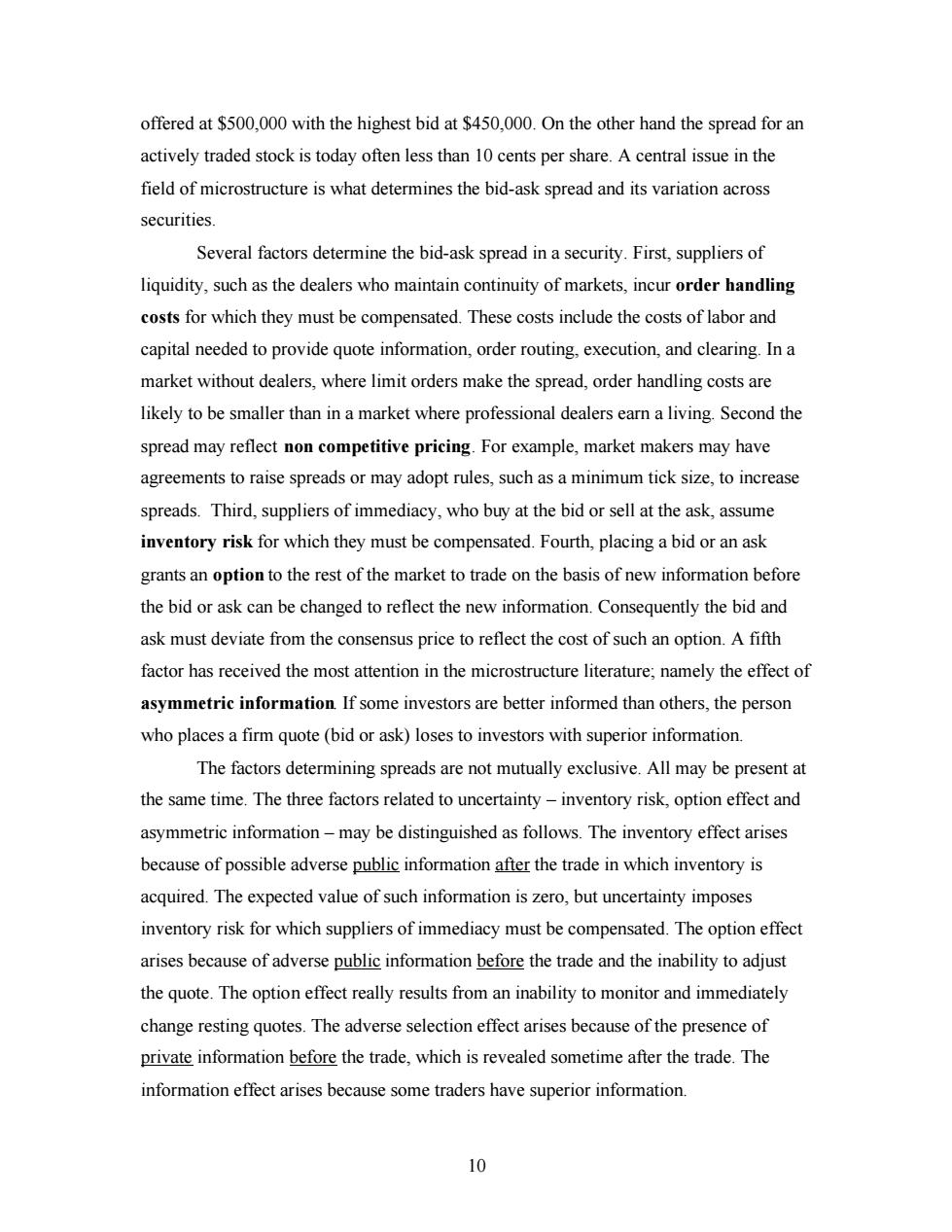
offered at $500,000 with the highest bid at $450,000.On the other hand the spread for an actively traded stock is today often less than 10 cents per share.A central issue in the field of microstructure is what determines the bid-ask spread and its variation across securities. Several factors determine the bid-ask spread in a security.First,suppliers of liquidity,such as the dealers who maintain continuity of markets,incur order handling costs for which they must be compensated.These costs include the costs of labor and capital needed to provide quote information,order routing,execution,and clearing.In a market without dealers,where limit orders make the spread,order handling costs are likely to be smaller than in a market where professional dealers earn a living.Second the spread may reflect non competitive pricing.For example,market makers may have agreements to raise spreads or may adopt rules,such as a minimum tick size,to increase spreads.Third,suppliers of immediacy,who buy at the bid or sell at the ask,assume inventory risk for which they must be compensated.Fourth,placing a bid or an ask grants an option to the rest of the market to trade on the basis of new information before the bid or ask can be changed to reflect the new information.Consequently the bid and ask must deviate from the consensus price to reflect the cost of such an option.A fifth factor has received the most attention in the microstructure literature;namely the effect of asymmetric information.If some investors are better informed than others,the person who places a firm quote(bid or ask)loses to investors with superior information The factors determining spreads are not mutually exclusive.All may be present at the same time.The three factors related to uncertainty-inventory risk,option effect and asymmetric information-may be distinguished as follows.The inventory effect arises because of possible adverse public information after the trade in which inventory is acquired.The expected value of such information is zero,but uncertainty imposes inventory risk for which suppliers of immediacy must be compensated.The option effect arises because of adverse public information before the trade and the inability to adjust the quote.The option effect really results from an inability to monitor and immediately change resting quotes.The adverse selection effect arises because of the presence of private information before the trade,which is revealed sometime after the trade.The information effect arises because some traders have superior information. 10
10 offered at $500,000 with the highest bid at $450,000. On the other hand the spread for an actively traded stock is today often less than 10 cents per share. A central issue in the field of microstructure is what determines the bid-ask spread and its variation across securities. Several factors determine the bid-ask spread in a security. First, suppliers of liquidity, such as the dealers who maintain continuity of markets, incur order handling costs for which they must be compensated. These costs include the costs of labor and capital needed to provide quote information, order routing, execution, and clearing. In a market without dealers, where limit orders make the spread, order handling costs are likely to be smaller than in a market where professional dealers earn a living. Second the spread may reflect non competitive pricing. For example, market makers may have agreements to raise spreads or may adopt rules, such as a minimum tick size, to increase spreads. Third, suppliers of immediacy, who buy at the bid or sell at the ask, assume inventory risk for which they must be compensated. Fourth, placing a bid or an ask grants an option to the rest of the market to trade on the basis of new information before the bid or ask can be changed to reflect the new information. Consequently the bid and ask must deviate from the consensus price to reflect the cost of such an option. A fifth factor has received the most attention in the microstructure literature; namely the effect of asymmetric information. If some investors are better informed than others, the person who places a firm quote (bid or ask) loses to investors with superior information. The factors determining spreads are not mutually exclusive. All may be present at the same time. The three factors related to uncertainty – inventory risk, option effect and asymmetric information – may be distinguished as follows. The inventory effect arises because of possible adverse public information after the trade in which inventory is acquired. The expected value of such information is zero, but uncertainty imposes inventory risk for which suppliers of immediacy must be compensated. The option effect arises because of adverse public information before the trade and the inability to adjust the quote. The option effect really results from an inability to monitor and immediately change resting quotes. The adverse selection effect arises because of the presence of private information before the trade, which is revealed sometime after the trade. The information effect arises because some traders have superior information
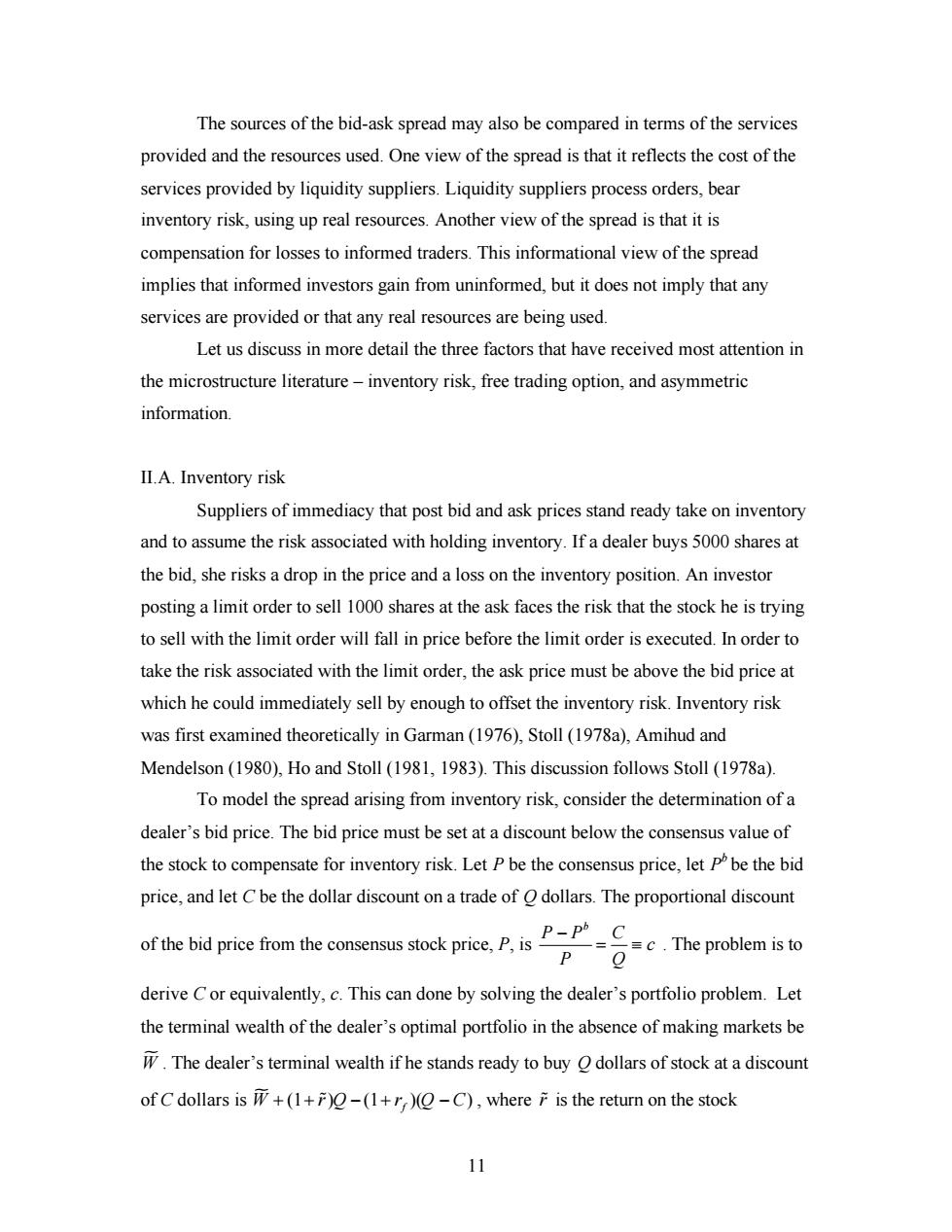
The sources of the bid-ask spread may also be compared in terms of the services provided and the resources used.One view of the spread is that it reflects the cost of the services provided by liquidity suppliers.Liquidity suppliers process orders,bear inventory risk,using up real resources.Another view of the spread is that it is compensation for losses to informed traders.This informational view of the spread implies that informed investors gain from uninformed,but it does not imply that any services are provided or that any real resources are being used. Let us discuss in more detail the three factors that have received most attention in the microstructure literature-inventory risk,free trading option,and asymmetric information. II.A.Inventory risk Suppliers of immediacy that post bid and ask prices stand ready take on inventory and to assume the risk associated with holding inventory.If a dealer buys 5000 shares at the bid,she risks a drop in the price and a loss on the inventory position.An investor posting a limit order to sell 1000 shares at the ask faces the risk that the stock he is trying to sell with the limit order will fall in price before the limit order is executed.In order to take the risk associated with the limit order,the ask price must be above the bid price at which he could immediately sell by enough to offset the inventory risk.Inventory risk was first examined theoretically in Garman (1976),Stoll(1978a),Amihud and Mendelson(1980),Ho and Stoll(1981,1983).This discussion follows Stoll (1978a). To model the spread arising from inventory risk,consider the determination of a dealer's bid price.The bid price must be set at a discount below the consensus value of the stock to compensate for inventory risk.Let P be the consensus price,let pbe the bid price,and let C be the dollar discount on a trade of O dollars.The proportional discount of the bid price from the consensus stock prieeisC =c.The problem is to P O derive Cor equivalently,c.This can done by solving the dealer's portfolio problem.Let the terminal wealth of the dealer's optimal portfolio in the absence of making markets be W.The dealer's terminal wealth if he stands ready to buy dollars of stock at a discount of C dollars is W+(1+)-(1+)(O-C),where is the return on the stock 11
11 The sources of the bid-ask spread may also be compared in terms of the services provided and the resources used. One view of the spread is that it reflects the cost of the services provided by liquidity suppliers. Liquidity suppliers process orders, bear inventory risk, using up real resources. Another view of the spread is that it is compensation for losses to informed traders. This informational view of the spread implies that informed investors gain from uninformed, but it does not imply that any services are provided or that any real resources are being used. Let us discuss in more detail the three factors that have received most attention in the microstructure literature – inventory risk, free trading option, and asymmetric information. II.A. Inventory risk Suppliers of immediacy that post bid and ask prices stand ready take on inventory and to assume the risk associated with holding inventory. If a dealer buys 5000 shares at the bid, she risks a drop in the price and a loss on the inventory position. An investor posting a limit order to sell 1000 shares at the ask faces the risk that the stock he is trying to sell with the limit order will fall in price before the limit order is executed. In order to take the risk associated with the limit order, the ask price must be above the bid price at which he could immediately sell by enough to offset the inventory risk. Inventory risk was first examined theoretically in Garman (1976), Stoll (1978a), Amihud and Mendelson (1980), Ho and Stoll (1981, 1983). This discussion follows Stoll (1978a). To model the spread arising from inventory risk, consider the determination of a dealer’s bid price. The bid price must be set at a discount below the consensus value of the stock to compensate for inventory risk. Let P be the consensus price, let P b be the bid price, and let C be the dollar discount on a trade of Q dollars. The proportional discount of the bid price from the consensus stock price, P, is b P P C c P Q - = º . The problem is to derive C or equivalently, c. This can done by solving the dealer’s portfolio problem. Let the terminal wealth of the dealer’s optimal portfolio in the absence of making markets be W° . The dealer’s terminal wealth if he stands ready to buy Q dollars of stock at a discount of C dollars is ° (1 ) (1 )( ) W f + + r% Q - + - rQC , where r% is the return on the stock
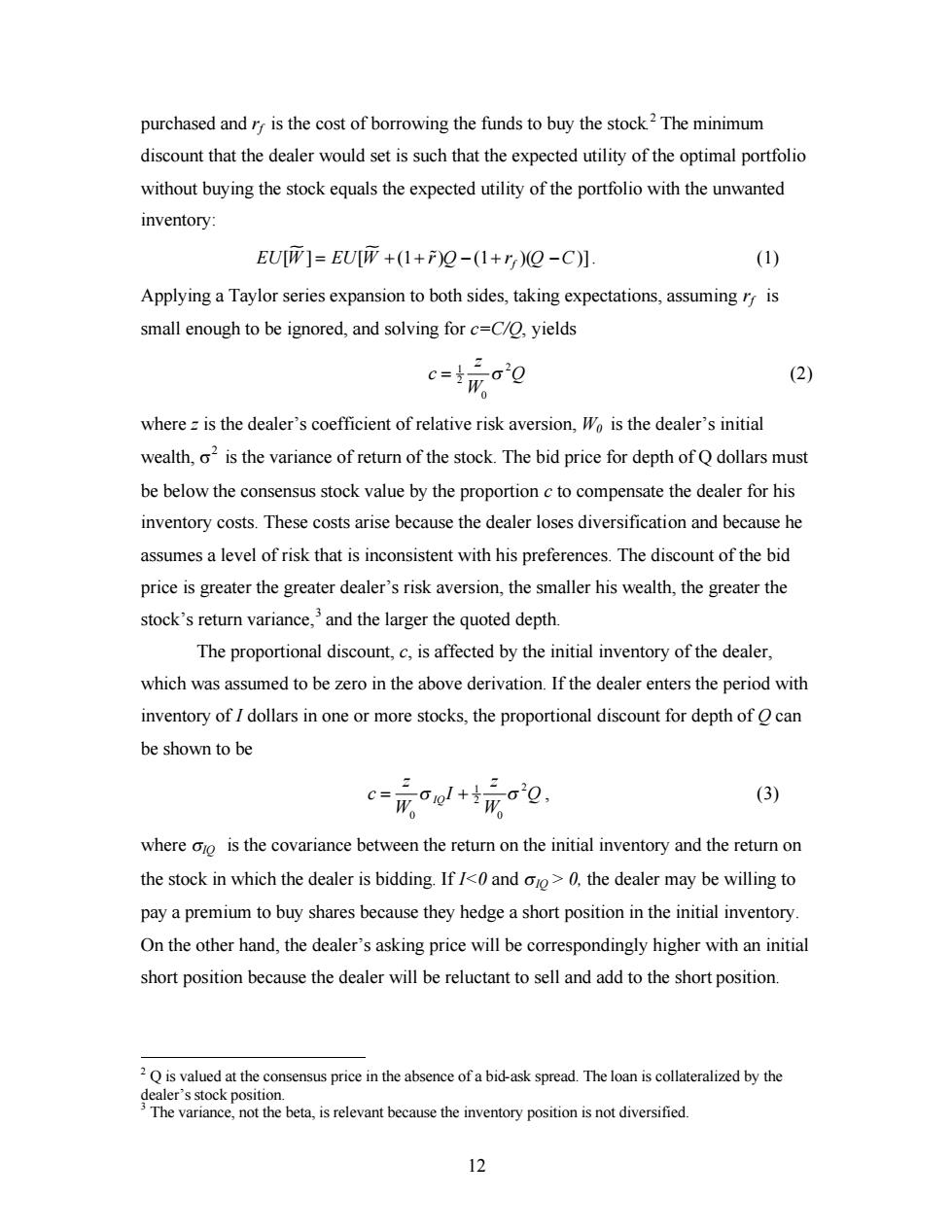
purchased and r is the cost of borrowing the funds to buy the stock?The minimum discount that the dealer would set is such that the expected utility of the optimal portfolio without buying the stock equals the expected utility of the portfolio with the unwanted inventory: EUm]=EU[W+(1+产2-(1+r)Q-C】 (1) Applying a Taylor series expansion to both sides,taking expectations,assuming ry is small enough to be ignored,and solving for c=C/O,yields (2) where z is the dealer's coefficient of relative risk aversion,Wo is the dealer's initial wealth,o2 is the variance of return of the stock.The bid price for depth of Q dollars must be below the consensus stock value by the proportion c to compensate the dealer for his inventory costs.These costs arise because the dealer loses diversification and because he assumes a level of risk that is inconsistent with his preferences.The discount of the bid price is greater the greater dealer's risk aversion,the smaller his wealth,the greater the stock's return variance,'and the larger the quoted depth. The proportional discount,c,is affected by the initial inventory of the dealer, which was assumed to be zero in the above derivation.If the dealer enters the period with inventory of I dollars in one or more stocks,the proportional discount for depth of can be shown to be C= (3) where oro is the covariance between the return on the initial inventory and the return on the stock in which the dealer is bidding.If /<0 and cto>0,the dealer may be willing to pay a premium to buy shares because they hedge a short position in the initial inventory. On the other hand,the dealer's asking price will be correspondingly higher with an initial short position because the dealer will be reluctant to sell and add to the short position. 2Q is valued at the consensus price in the absence of a bid-ask spread.The loan is collateralized by the dealer's stock position. The variance,not the beta,is relevant because the inventory position is not diversified. 12
12 purchased and rf is the cost of borrowing the funds to buy the stock. 2 The minimum discount that the dealer would set is such that the expected utility of the optimal portfolio without buying the stock equals the expected utility of the portfolio with the unwanted inventory: [ °] [ ° (1 ) (1 )( )] EU W EU W f = + + r% Q - + - rQC . (1) Applying a Taylor series expansion to both sides, taking expectations, assuming rf is small enough to be ignored, and solving for c=C/Q, yields 1 2 2 0 z c Q W = s (2) where z is the dealer’s coefficient of relative risk aversion, W0 is the dealer’s initial wealth, s 2 is the variance of return of the stock. The bid price for depth of Q dollars must be below the consensus stock value by the proportion c to compensate the dealer for his inventory costs. These costs arise because the dealer loses diversification and because he assumes a level of risk that is inconsistent with his preferences. The discount of the bid price is greater the greater dealer’s risk aversion, the smaller his wealth, the greater the stock’s return variance,3 and the larger the quoted depth. The proportional discount, c, is affected by the initial inventory of the dealer, which was assumed to be zero in the above derivation. If the dealer enters the period with inventory of I dollars in one or more stocks, the proportional discount for depth of Q can be shown to be 1 2 2 0 0 IQ z z c I Q W W = + s s , (3) where sIQ is the covariance between the return on the initial inventory and the return on the stock in which the dealer is bidding. If I<0 and sIQ > 0, the dealer may be willing to pay a premium to buy shares because they hedge a short position in the initial inventory. On the other hand, the dealer’s asking price will be correspondingly higher with an initial short position because the dealer will be reluctant to sell and add to the short position. 2 Q is valued at the consensus price in the absence of a bid-ask spread. The loan is collateralized by the dealer’s stock position. 3 The variance, not the beta, is relevant because the inventory position is not diversified
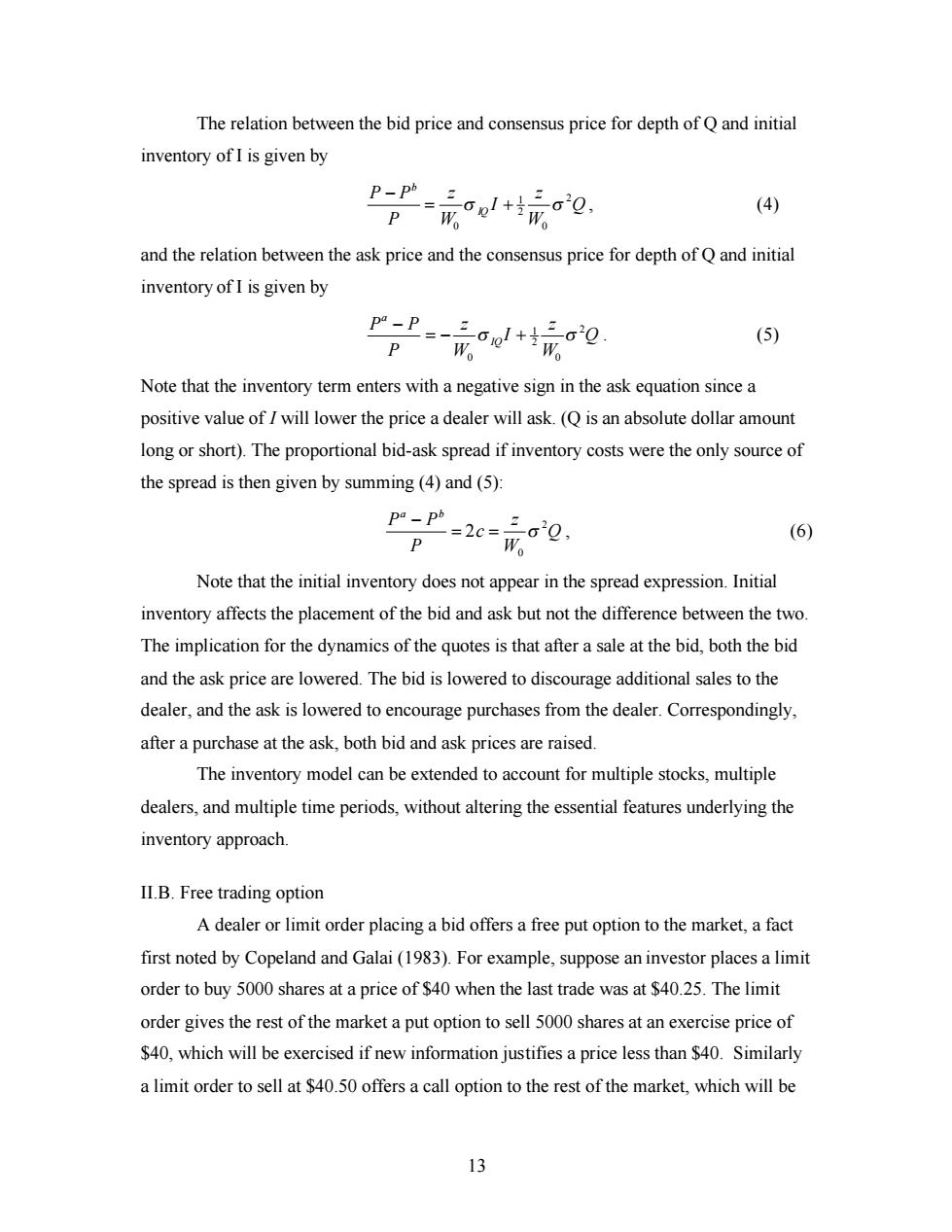
The relation between the bid price and consensus price for depth of Q and initial inventory of I is given by P-pb P Wo 元o20, (4) and the relation between the ask price and the consensus price for depth of Q and initial inventory of I is given by p4-P -三6@1+形。20 (5) PW。 Note that the inventory term enters with a negative sign in the ask equation since a positive value of I will lower the price a dealer will ask.(Q is an absolute dollar amount long or short).The proportional bid-ask spread if inventory costs were the only source of the spread is then given by summing(4)and(5): p=2c=0, pa-pb (6) W。 Note that the initial inventory does not appear in the spread expression.Initial inventory affects the placement of the bid and ask but not the difference between the two. The implication for the dynamics of the quotes is that after a sale at the bid,both the bid and the ask price are lowered.The bid is lowered to discourage additional sales to the dealer,and the ask is lowered to encourage purchases from the dealer.Correspondingly, after a purchase at the ask,both bid and ask prices are raised. The inventory model can be extended to account for multiple stocks,multiple dealers,and multiple time periods,without altering the essential features underlying the inventory approach. II.B.Free trading option A dealer or limit order placing a bid offers a free put option to the market,a fact first noted by Copeland and Galai(1983).For example,suppose an investor places a limit order to buy 5000 shares at a price of $40 when the last trade was at $40.25.The limit order gives the rest of the market a put option to sell 5000 shares at an exercise price of $40,which will be exercised if new information justifies a price less than $40.Similarly a limit order to sell at $40.50 offers a call option to the rest of the market,which will be 13
13 The relation between the bid price and consensus price for depth of Q and initial inventory of I is given by 1 2 2 0 0 b IQ P P z z I Q P W W s s - = + , (4) and the relation between the ask price and the consensus price for depth of Q and initial inventory of I is given by 1 2 2 0 0 a IQ P P z z I Q P W W s s - = - + . (5) Note that the inventory term enters with a negative sign in the ask equation since a positive value of I will lower the price a dealer will ask. (Q is an absolute dollar amount long or short). The proportional bid-ask spread if inventory costs were the only source of the spread is then given by summing (4) and (5): 2 0 2 a b P P z c Q P W s - = = , (6) Note that the initial inventory does not appear in the spread expression. Initial inventory affects the placement of the bid and ask but not the difference between the two. The implication for the dynamics of the quotes is that after a sale at the bid, both the bid and the ask price are lowered. The bid is lowered to discourage additional sales to the dealer, and the ask is lowered to encourage purchases from the dealer. Correspondingly, after a purchase at the ask, both bid and ask prices are raised. The inventory model can be extended to account for multiple stocks, multiple dealers, and multiple time periods, without altering the essential features underlying the inventory approach. II.B. Free trading option A dealer or limit order placing a bid offers a free put option to the market, a fact first noted by Copeland and Galai (1983). For example, suppose an investor places a limit order to buy 5000 shares at a price of $40 when the last trade was at $40.25. The limit order gives the rest of the market a put option to sell 5000 shares at an exercise price of $40, which will be exercised if new information justifies a price less than $40. Similarly a limit order to sell at $40.50 offers a call option to the rest of the market, which will be